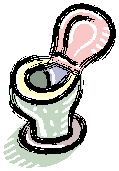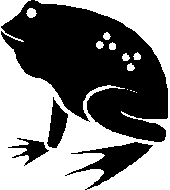The Most-Traveled Cane Toad
Toad'ly Habits!
This is a random funky facts page, so you get to be curious and read everything!
-A Colombian fossil of the cane toad is identical to the present-day cane toad.

-Cane toads urinate in their home site, so as to maintain moisture in their bedding. (I guess they don't have to worry about getting up to find the toilet when they're dozing.)
-Cane toads can resorb water from their bladder. And, they drink through special patches on their rear ends. (Not as civil as you and I, but the toads don't care. They'll do anything in front of anyone.)

-Cane toads regularly eat their skin through a process called exuviation. The toad inflates its body and makes twisting movements until the old skin splits down the middle of the toad’s back. Once the skin splits, the toad starts swallowing the skin, which is swallowed in one continuous piece. Yummy! This is the equivalent of a human bath…it removes the old skin and dirt and any colonizing microorganisms. (Be glad that you can simply shower.)
-The cane toad likes to grow…big. It is the largest of toads. It can grow to 9 inches in length and weigh 1 kg (2.2 pounds). Exceptionally large individuals are 2.5 kg and 10 inches.
 -Cane toads may eat their young.
But then again, cane toads eat anything that fits in
their mouths, including rodents, birds, snakes, lit cigarette
butts, ping pong balls, and even feces.
They’ll also eat rotting vegetation and even pet food.
They’ll learn a pet’s feeding schedule.
-Cane toads may eat their young.
But then again, cane toads eat anything that fits in
their mouths, including rodents, birds, snakes, lit cigarette
butts, ping pong balls, and even feces.
They’ll also eat rotting vegetation and even pet food.
They’ll learn a pet’s feeding schedule.
-The cane toad loves colonizing. It is a very adaptive creature and is willing to attempt life wherever humans may place them. They can breed in waters with a pH of 2.0 (the acidity of lemon juice), such as occurs after volcanic activity.
-In the early 1990s, bufotoxin cost $100
per gram. (No, I don’t know its current
price, but don't buy it anyway).
-The cane toad has been known to actually approach its own predators. It will either face its predator, put its head down and raise its back, or turn sideways and lift the far side of its body. Through these actions, the toad is exposing its poison glands to the predators. It can actually shoot poison if it feels exceptionally threatened.
-The cane toad doesn’t just use its ears to
hear. It uses the vibrations from its front
limbs. It will also use forearm signaling to
communicate, if for some reason it isn’t being heard.
-The cane toad “feels” the weather change. Its ears and lungs are directly connected, so it may be able to sense changes in barometric pressure.
-When it walks, the toad momentarily closes its eyes when altering the elevation of its body. This helps to prevent motion sickness!
 -The young keep different waking hours than
do adults. Metamorphs are awake during the
day, but about 4 days after metamorp
-The young keep different waking hours than
do adults. Metamorphs are awake during the
day, but about 4 days after metamorp hosis they transition to the
night life. But, they don’t keep very late
hours: adults are most active 1-2 hours after dusk, with
decreasing activity until midnight. Hardly
any toads are active after midnight. This
lack of activity may be due to daily metabolic cycles, but
perhaps activity increases metabolism. So
it’s a question of causation, better known as the classic “which
comes first – chicken or egg”.
hosis they transition to the
night life. But, they don’t keep very late
hours: adults are most active 1-2 hours after dusk, with
decreasing activity until midnight. Hardly
any toads are active after midnight. This
lack of activity may be due to daily metabolic cycles, but
perhaps activity increases metabolism. So
it’s a question of causation, better known as the classic “which
comes first – chicken or egg”.
Sadly, that's the end of my current list of funky toad habits. But I'm sure more exist. I just have to keep thinking and researching. For now, placate yourself with Anuran odds n' ends.